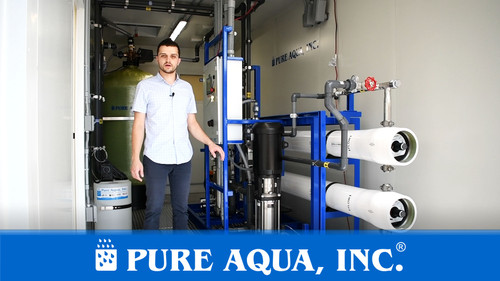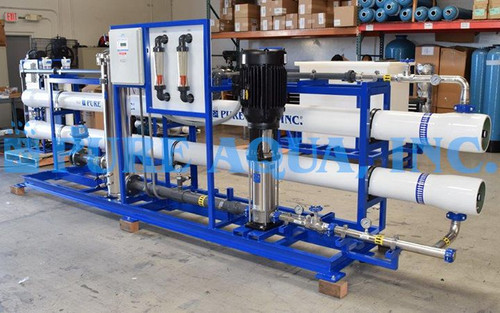Overview: This industrial brackish reverse osmosis system was designed to reduce the conductivity in well water for a Petroleum Refinery in Bangladesh.
Industry: Oil Refinery
This industrial brackish reverse osmosis system is model #TW-158K-4680 from our RO-400 Series.
- (4) FRP pressure vessels codeline rated at 300 PSI, 3:1 array
- (24) 8" TFC spiral wound membranes Hydranautics ESPA2-LD
- Pressure gauges as needed, (1) conductivity meter on product line and with signet ORP on feed line
- Low- & high-pressure switches
- (2) Signet Flow meters for reject and product line
- High pressure pump CRN45-5
- 1-micron pre-filter with SS housing SSC-48-316
- Siemens S7-1200 Advanced PLC based Control Panel
- Carbon steel skid
[custom-specifications]
Water Concern: Water supplied to oil refineries vary depending on the process in which it would be used. There are multiple steps in the refinery process and different water may be used for some steps. The water derived from surface sources often include metals, organics, and both dissolved and suspended solids. These characteristics can interfere with the refining process and cause long term issues with the equipment. Of those characteristics, conductivity is a common parameter in well water that can cause corrosion to occur and requires treatment to reduce. Reducing the total dissolved solids (TDS) would in directly reduce the level of conductivity. While some steps may not require the water to be treated, majority do. Therefore, an effective water treatment system was necessary to effortlessly facilitate the process of petroleum refinery.
[/custom-specifications]
[custom-features]
Applied Solution: This industrial brackish reverse osmosis system was recommended to treat well water by reducing the conductivity for a petroleum refinery. A reverse osmosis system requires the water to be pre-treated before passing through the RO membranes. The entire system consists of a six-step process including the pre-treatment. As the water enters the system it is perchlorinated to reduce the potential of bio-fouling in the following systems. Next, the water is pumped into Multi-Media Filters (a greensand filter is provided for this particular case to reduce high accounts of iron and manganese). Then, a dechlorination process is supplied to condition the water prior to contact with the RO membranes. Prior to the cartridge filters, the water is injected with antiscalant to decrease the potential of scaling. Lastly, the water is pressurized into the RO membrane system to produce an ultra-pure stream and a concentrated stream of contaminants. The RO membranes effectively reduce the TDS by 99% leaving the permeate water stream ultra-purified.
[/custom-features]
[custom-usage]
Low operating cost, compact size, reduced footprint, and high quality production of freshwater.
[/custom-usage]
Industrial Reverse Osmosis System for Oil Refinery (Conductivity Reduction) 159,000 GPD - Bangladesh - Data Sheet[/custom-documents]
-
Price is great and quality is equally great too.
We are satisfied with our investment. Will be buying again
 ENGLISH
ENGLISH ESPAÑOL
ESPAÑOL العربية
العربية PORTUGUÉS
PORTUGUÉS FRANÇAIS
FRANÇAIS





















